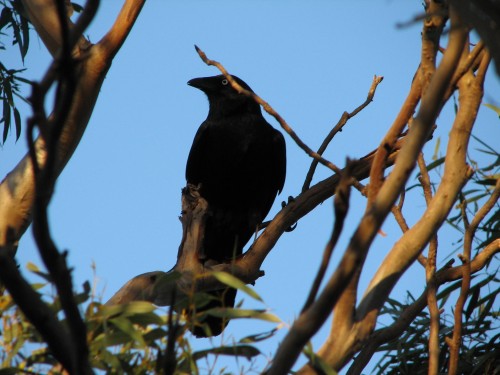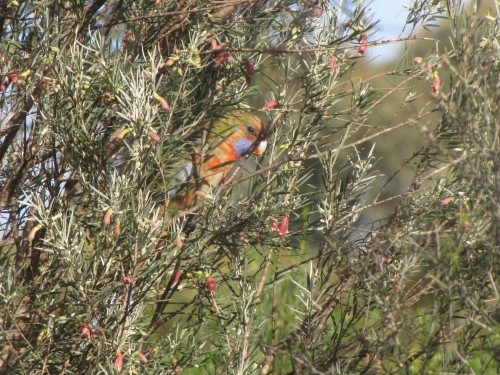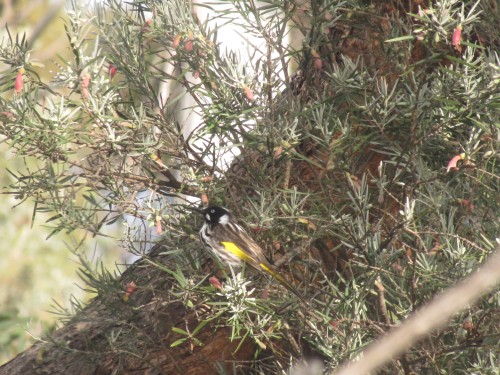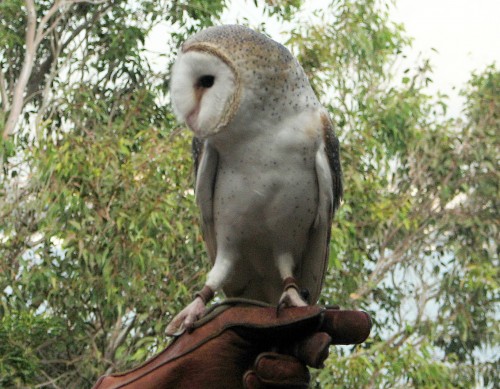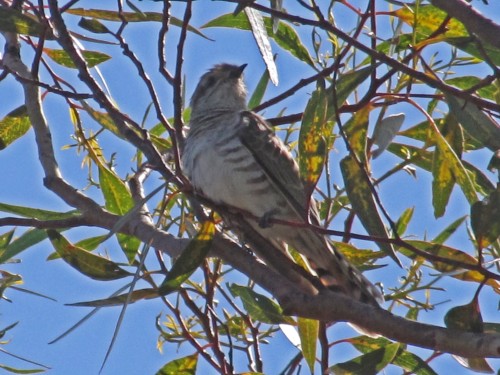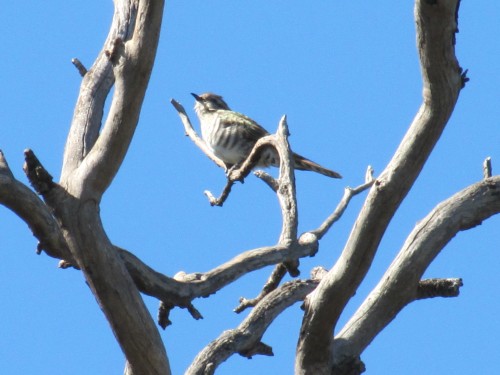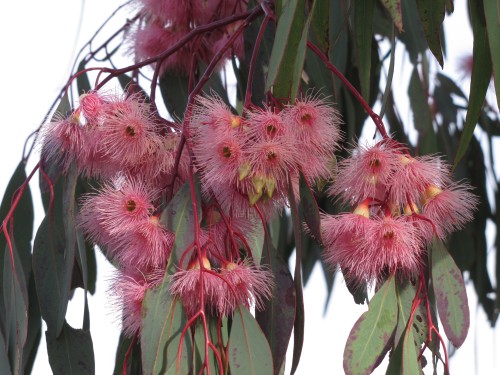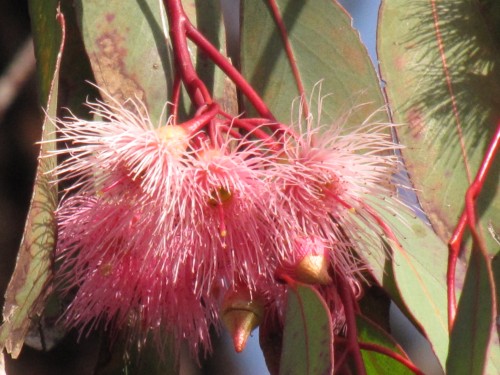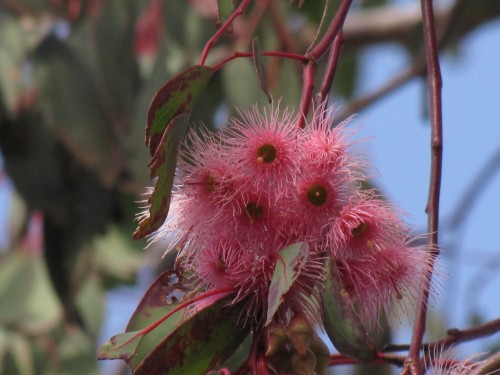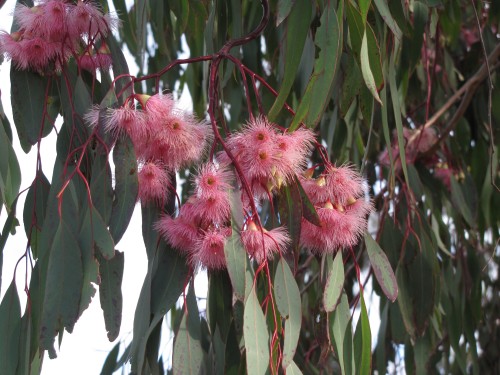Crows using tools
I have written before about how clever crows and ravens can be. This is a well established fact and people around the world have witnessed how intelligent the corvid family can be. In fact, if you do a search for videos of these birds using tools you will find many hundreds of them; I have provided a link below.
Earlier this week I witnessed first hand one of the Little Ravens in our garden actually using a tool to assist in finding food. It had picked up what looked like a flat rock and was progressively using it to prise bark off the trunk of a mallee tree near the house. Once the bark was lifted it dropped the stone and used its beak to grab whatever was hiding beneath the bark.
Spiders, beetles and a whole range of small creatures routinely live under the bark of the local trees. Several times the bird flew down to the ground to retrieve the stone in order to use it again for the same purpose. After about three or four little snacks it flew off, stone in its beak to another tree, this time out of sight.
Of course, I didn’t have my camera handy at the time. [Sigh]
Further reading:
- Clever crows – articles from my archives
- Corvids – links to more articles about crows and ravens
- Videos of crows using tools
- Little Ravens feeding their young
- A very clever crow
Feeding Adelaide Rosellas
Last weekend we were having breakfast in our sun-room when four Adelaide Rosellas flew into one of the bushes in our garden, an Eremophila youngii (see photo above). I had the camera ready for many minutes but they would not come out into full sunlight and the above photo is the best I captured on this occasion. Just one bird is seen peeking out to see what was happening around it. The others were hidden in the foliage, busy feeding on the nectar in the flowers.
The Adelaide Rosella is now a frequent visitor to our garden. It is a race of the widespread Crimson Rosella and confined to the Adelaide region, Mt Lofty Ranges and mid-north of South Australia. Its occurrence here in Murray Bridge is a relatively recent extension of that range.
Parrots occurring in our garden in Murray Bridge include:
- Adelaide Rosella (regular visitor, possibly breeding)
- Crimson Rosella (occasional)
- Eastern Rosella (regular)
- Mallee Ringneck (resident breeding)
- Galah (resident breeding)
- Rainbow Lorikeet (regular)
- Purple-crowned Lorikeet (regular)
- Musk Lorikeet (occasional)
- Budgerigar (rare)
- Sulphur-crested Cockatoo (rare)
- Little Corella (occasional)
- Yellow-tailed Black-cockatoo (once only)
- Cockatiel (occasional)
- Red-rumped Parrot (occasional)
Over the years we have lived here we have planted many native Australian plants, not only for their attractiveness when they flower, but also to attract our native wildlife, especially the birds. We have quite a few eremophilas, grevilleas and correas as well as many others. The particular bush shown in the photo has flowers on it for much of the year so the rosellas and honeyeaters head for it on a daily basis. Below is another photo of the same bush, this time with a New Holland Honeyeater having a feed.
Further reading:
- Get out of my patch
- Red wattlebird in Eremophila bush
- Mallee Native Plants Nursery – my wife’s site about Australian plants
Cold weather birding
I didn’t do much birding today.
Or yesterday.
I decided that the weather was far too cold. We are having a really cold winter’s snap here in South Australia with heavy rain, very cold temperatures, blustery winds and even snow. Snow in our state is such a rarity it receives plenty of coverage in the news. We average one snow fall every few years and it only lasts a few moments on the ground – if it reaches the ground. Nothing like the countries where some of my readers reside, I know, but then you don’t have to contend with our severe summers which we take in our stride. Or our snakes. Or spiders. Or sharks… you get the picture?
Despite the cold, inclement weather I was still able to be aware of the birds in and around our home and garden. The New Holland Honeyeaters and Red Wattlebirds were busily feeding on a few native plants and trees which are currently flowering. The Australian Magpies have stopped fussing about whether it is time to start building nests yet. A small party of White-browed Babblers scratched their way through the leaf litter a few days ago and the little family of Superb Fairy-wrens always seem to be happy to flit and hop around the garden, no matter what the weather dishes up.
Yesterday I noticed two Little Ravens scratching around in the grass I haven’t mowed recently. They seemed to be having a good feast. A few days ago I also heard several Grey Currawongs calling but they must have been just passing through our mallee scrub and not stopping. Earlier in the week I heard a Barn Owl screeching outside during the evening; we had visitors at the time so I didn’t go out searching for it.
Further reading:
- Just click on the name of any of the species mentioned in this post. A link will take you to photos and stories about each of the species mentioned. Reading those articles might help you to while away some poor weather in your part of the world.
An early Horsfield’s Bronze-cuckoo
I meant to write this post about two weeks ago. I have been distracted by other things; it happens.
First thing one morning just on two weeks ago I was on my way out and I heard the distinctive call of a Horsfield’s Bronze-cuckoo. I was running late for a meeting so I didn’t have time to track it down and get a photo but I know its call from years of hearing it around our home and garden. The photos I have shared today were taken some time ago and are not brilliant, but they give you a general idea of the appearance of this species.
What was interesting about this record is the early nature of the visit in late June. Most of the cuckoos we see and hear on our property are later in the year, especially around spring time when many species are nesting. I have also been reading quite a few reports online by other birders of various cuckoos appearing in southern Australia in recent weeks. One field guide I consulted claims that this species migrates to southern Australia and breeds from June to March, so it is not really all that early after all.
Sometimes I wonder if our birds actually read the field guides and follow the instructions therein.
Red Wattlebirds and Eucalypts
Red Wattlebirds are one of the largest species of honeyeater in Australia. They are also one of the more common species of honeyeater over their range which is southern Australia.
The Red Wattlebird is a resident breeding species in our garden and on our five acre block of mallee scrub here in Murray Bridge, South Australia. We see them every day and we hear them calling throughout the day. During the warmer days they are frequent visitors to our bird baths, bullying most other species away from the water.
Over recent days we have been observing several wattlebirds feeding on the flowers of the Eucalyptus sideroxylon rosea tree in our drive-way. The common name of the tree is Red Iron-bark. I tried to get a photo of one of them feeding on the flowers but they always flew away before I could sneak up within camera range.
So – instead of getting frustrated by my lack of photos of the feeding birds, I have decided to show some photos of the flowers of the trees for your enjoyment.
Further reading:
